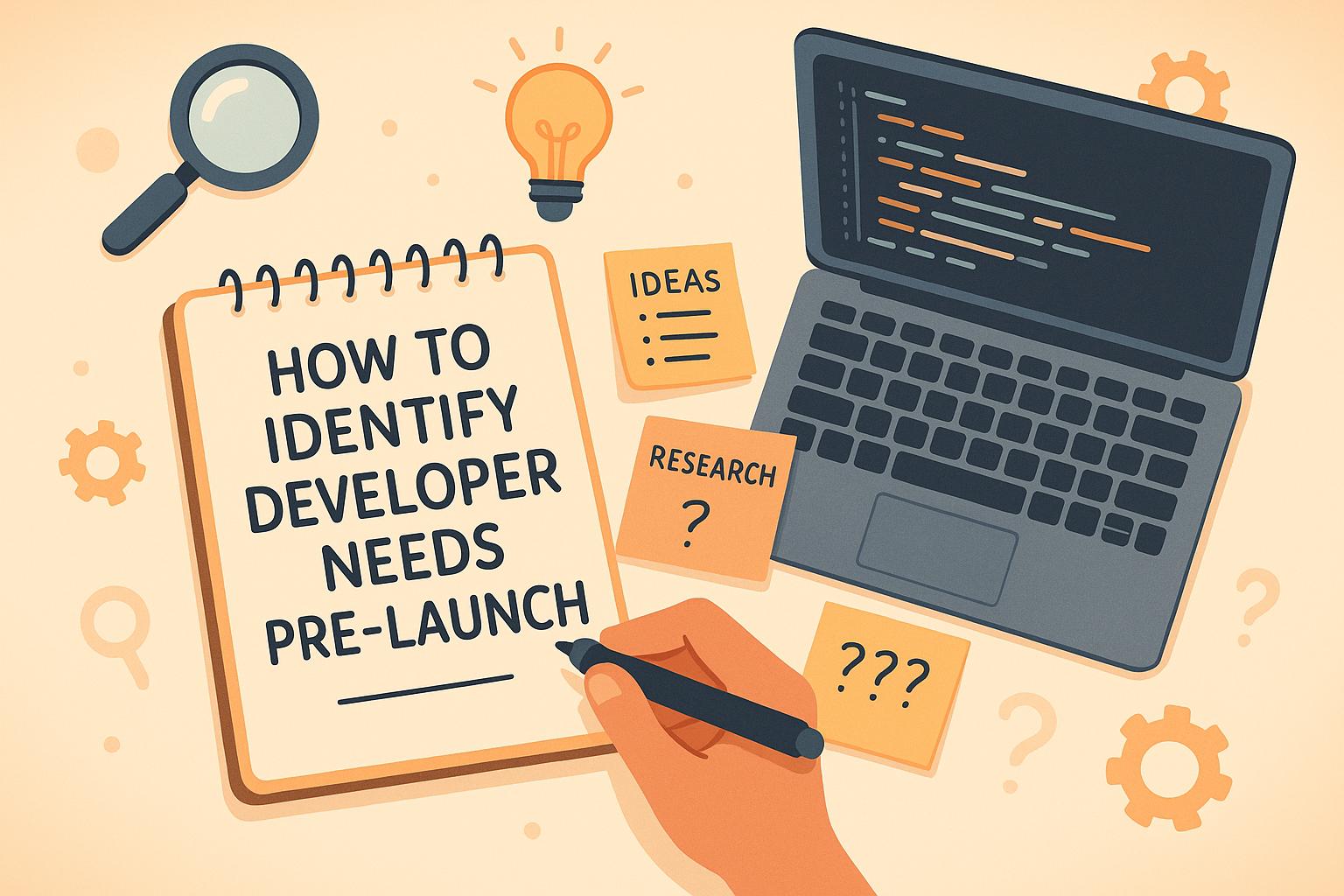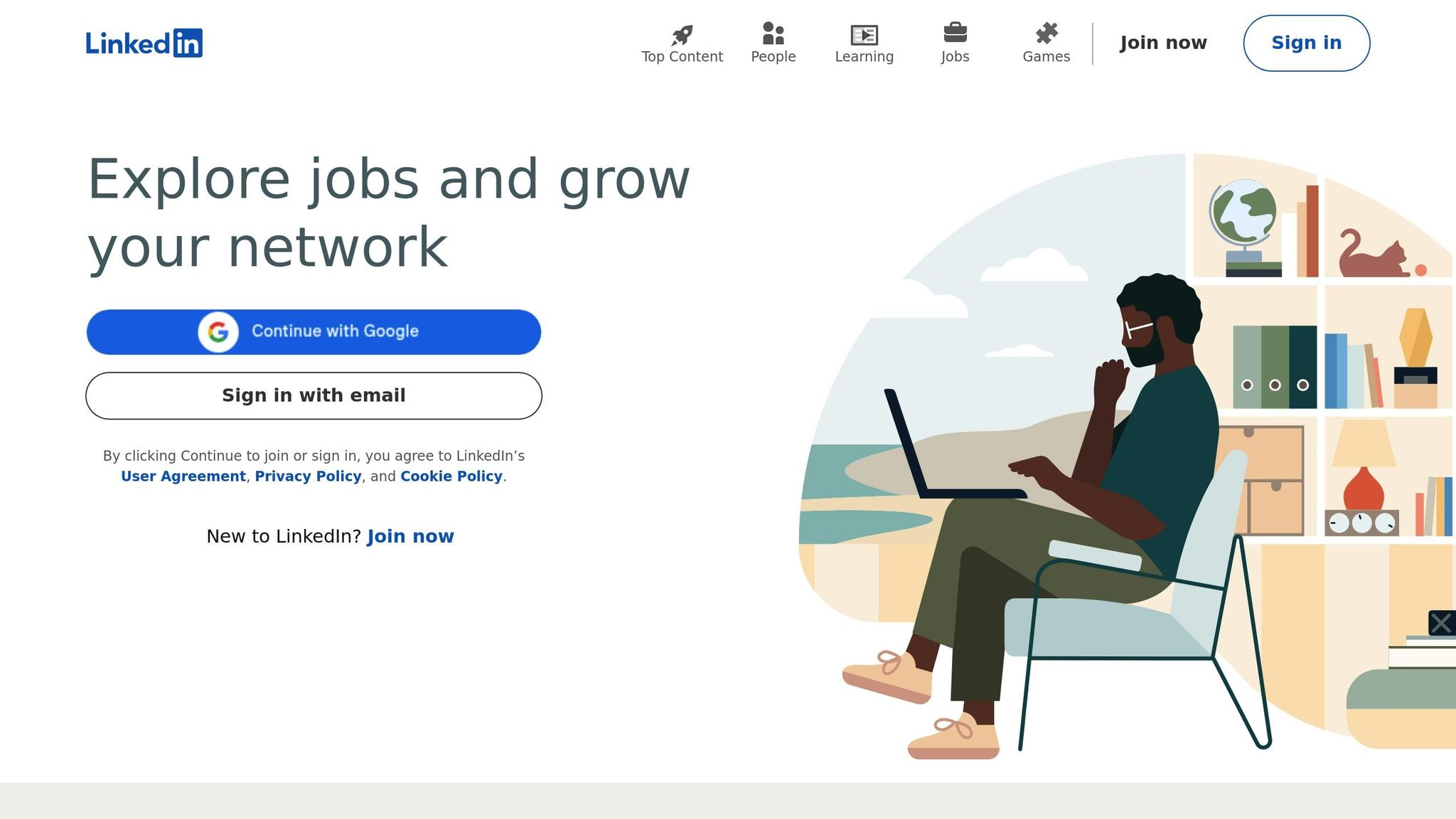


Understand developer needs before launch to enhance product success. Use research methods to pinpoint pain points and validate ideas.
Creating a product without understanding developer needs is a recipe for failure. Research shows 95% of products fail, often due to a lack of market need. To avoid this, you must pinpoint developer pain points, validate assumptions early, and align your product with their workflows before launch. Here's how to do it:
- Talk to Developers: Conduct interviews, focus groups, and surveys to gather direct feedback.
- Leverage Existing Data: Analyze platforms like Stack Overflow, GitHub, and Reddit for recurring challenges.
- Observe Behavior: Monitor how developers use tools to uncover gaps between what they say and do.
- Test Your Ideas: Use experiments, landing pages, and surveys to validate concepts and messaging.
- Prioritize Feedback: Turn insights into actionable product decisions by ranking pain points and aligning them with business goals.
Webinar: Market Research to Drive Product Strategy by LinkedIn PM, Ankit Desai

Research Methods for Understanding Developer Needs
To truly understand what developers need, it's essential to combine multiple research methods. This approach helps identify pain points, workflows, and priorities, uncovering both obvious challenges and hidden issues that might otherwise go unnoticed. These insights play a crucial role in shaping feature prioritization and refining product messaging later on. By laying this groundwork, you can extract meaningful and actionable insights in the next phases.
Direct Developer Research
Talking directly to developers through interviews, focus groups, and surveys provides a clear window into their experiences and challenges. Interviews are a great way to dig into the motivations behind their behaviors, while focus groups can uncover insights that individual interviews might miss. For instance, the Membership Puzzle Project collaborated with De Correspondent in the summer of 2017, using a screening survey to select focus group participants from a variety of roles and backgrounds, ensuring a wide range of perspectives. Surveys, when kept short and carefully tested before being sent out, are particularly effective for collecting targeted quantitative feedback.
Once you've gathered direct feedback, you can enhance your understanding by diving into existing data sources.
Using Existing Data Sources
Secondary research, like analyzing existing data, can shed light on common developer challenges. Platforms like Stack Overflow, Reddit, and specialized Discord servers often highlight recurring issues with APIs, frameworks, and tools. Support tickets and GitHub issues can also reveal where developers face onboarding hurdles or encounter technical glitches. Additionally, tracking onboarding events provides behavioral data that complements other findings. AI tools can help sift through feedback on these platforms, identifying recurring themes such as performance bottlenecks or deployment struggles. For example, one study manually reviewed 825 posts on the devRant forum during the early days of COVID-19, categorizing them into 19 topics across six themes. This analysis revealed how external factors shaped developer priorities.
The next step involves observing developers in action to gain even deeper insights.
Observing Developer Behavior
Watching how developers work can reveal discrepancies between what they say and what they actually do. Monitoring community activity - like frequently asked questions, shared resources, and trending discussions - can highlight both ongoing challenges and new needs as they emerge. Workflow analysis uncovers friction points such as communication breakdowns or unclear processes. Meanwhile, analyzing system logs, performance metrics, and user interactions provides an objective view of how developers engage with tools and platforms. Creating an environment of psychological safety is just as important; developers need to feel comfortable sharing honest feedback without fear of criticism. By combining these perspectives, you can form a well-rounded understanding of developer experiences and make product decisions that genuinely address their needs.
Finding and Ranking Developer Pain Points
To truly address developer challenges, it’s essential to turn research into actionable insights. This involves gathering structured feedback, tapping into community discussions, and comparing various research methods to uncover the most pressing issues developers face.
Collecting Structured Feedback
Creating direct feedback channels is a smart way to guide product decisions. The goal is to capture both measurable data and deeper, qualitative insights from developers.
When designing surveys, keep them short - just 3–5 questions that mix numerical ratings with open-ended queries. This strikes a balance: you’ll avoid overwhelming respondents while still gathering meaningful insights. Timing is everything - place surveys within your product or during critical workflow moments to boost response rates.
"Collecting user feedback through meaningful user research is one of the most important things you can do as a product manager to make your product successful." - theproductmanager.com
Regular, short interviews with developers can provide the context behind survey data. These conversations create a feedback loop that evolves as developer needs change. Focus these interviews on validating your core assumptions. Instead of just collecting feature requests, dig into why developers behave the way they do. This approach separates surface-level complaints from deeper workflow issues that could influence your entire product strategy.
While structured feedback is vital, spontaneous insights from developer communities are just as valuable.
Monitoring Community Conversations
Developer communities are a treasure trove of unfiltered insights into recurring challenges. Platforms like Stack Overflow, Reddit, and GitHub are especially useful for spotting patterns in developer struggles.
GitHub, for example, is full of issues, pull requests, and discussions that often highlight shared pain points across projects and organizations. Social media platforms like Twitter also offer real-time glimpses into developer sentiment. Hashtags such as #100DaysOfCode frequently showcase obstacles developers face while learning or implementing new technologies.
Meanwhile, platforms like Discord and Slack provide a different kind of insight. Their conversational nature often captures raw emotional reactions to tools or workflows - frustrations that might not appear in more formal feedback channels. These real-time discussions can reveal gaps in developer experience that structured surveys might miss.
The next step is to compare and validate these findings using different research methods.
Research Method Comparison
Each research method offers unique insights into developer pain points. By understanding their strengths and limitations, you can combine them effectively to prioritize challenges.
| Research Method | Primary Benefit | Key Focus | Best For |
|---|---|---|---|
| Developer Interviews | Reveals individual motivations | Direct conversations about workflows | Understanding the "why" behind behaviors |
| Community Monitoring | Highlights community trends | Online discussions and recurring issues | Identifying widespread problems |
| Behavioral Analytics | Maps actual usage patterns | System logs and user interactions | Finding gaps between stated and actual needs |
Start with qualitative research to uncover developer frustrations that might not be obvious in structured data. Surveys and analytics are helpful for validation but often miss insights developers struggle to articulate.
Interviews are excellent for exploring the reasoning behind developer decisions but can be time-consuming and might not reflect broader trends. On the other hand, community monitoring captures widespread issues but requires filtering out irrelevant noise. Behavioral analytics, while objective, needs context from qualitative research to explain why certain patterns emerge.
"Through continuous user feedback loops, you are ensuring at every point that you are working on something useful and valuable to customers. This reduces risk and cost throughout the development cycle massively." - theproductmanager.com
The best approach combines all three methods. Use interviews to dive into individual experiences, community monitoring to validate those findings at scale, and behavioral data to confirm actual usage trends. By triangulating these insights, you can differentiate genuine pain points from isolated complaints and ensure your product decisions address real developer needs.
When a challenge consistently appears across multiple research methods and impacts a significant portion of your audience, prioritization becomes much clearer.
sbb-itb-e54ba74
Testing Developer Insights Through Experiments
After identifying potential pain points for developers, the next key step is validating these insights through experiments. This process helps distinguish actual needs from assumptions, ensuring your product decisions align with how developers truly behave. Testing should begin early in your development cycle - when you have a viable product concept but before making major investments. This phase sharpens both your product ideas and messaging, as explained below.
Testing Product Concepts
Testing product concepts through targeted campaigns aimed at specific developer groups is a great way to gauge interest, gather feedback, and refine your approach before diving into full development.
Start by defining clear objectives for each test. Are you validating a core feature? Testing messaging strategies? Identifying which developer personas are most interested? Clarify these goals upfront, and outline your test scope, cases, and methods.
Platforms like daily.dev Ads can be extremely helpful here, offering the ability to reach developers based on their interests, experience levels, programming languages, and tools. For example, you can target JavaScript developers working on frontend frameworks or DevOps engineers focused on cloud infrastructure - whatever matches your audience.
Diversity in your tester pool is also crucial. Include developers from various backgrounds, experience levels, and company sizes to see how your concept resonates across a broad spectrum of users - not just early adopters.
Compare different versions of your product concept to see what works best. Test variations in messaging, feature focus, or visual design to understand developer preferences and behaviors.
For the most accurate results, simulate real-world conditions. Present your concept in contexts where developers would naturally encounter similar tools, and track metrics like click-through rates, engagement time, and conversion rates. After validating your concept, a well-designed landing page can further measure developer interest.
Building Pre-Launch Landing Pages
Pre-launch landing pages are powerful tools for gauging developer interest and securing early commitments. They serve as your first impression and a way to test your product's appeal before launch.
A good developer-focused landing page should include:
- A clear headline that communicates your value proposition.
- Specific benefits tailored to developer workflows.
- Engaging visuals that showcase your product in action.
- A strong call-to-action and a lead capture form to measure genuine interest.
To identify serious interest, consider requiring small commitments, like connecting a GitHub account, completing a short survey, or joining a private Slack group. These steps help filter out casual visitors and highlight genuinely interested developers.
Encourage sharing to expand your reach. Offer incentives like moving up a waitlist for referrals, early access to beta features, or exclusive developer resources. Developers often share tools within their networks, so this can significantly boost your sample size.
Keep in mind that 83% of landing page visits happen on mobile devices, so ensure your page performs well across all devices. Additionally, with 70% of consumers saying loading time impacts their buying decisions, page speed is critical for accurate validation.
Use your landing page experiments to test different elements - headlines, images, copy, or calls-to-action. This data will be invaluable for fine-tuning your messaging before launch.
Creating Targeted Surveys
While landing pages measure interest, targeted surveys dig deeper into how well your product features and messaging resonate with developers. Surveys provide detailed insights that guide the refinement process.
Survey length is a big factor in completion rates - shorter surveys are more likely to be completed. For developers, this means asking only the most important questions. Focus on specific workflow challenges, tool frustrations, and feature priorities rather than broad preferences.
Segment your developer audience before creating surveys. Divide them by programming languages, experience levels, company sizes, or technologies to ensure your questions are relevant and actionable.
For example, a PickFu user tested six features of a handheld showerhead by asking respondents to rank them: easy-to-clean nozzles, high-quality materials, tool-free DIY installation, high-pressure spray, and a six-spray function. The six-spray function ranked highest, followed by high-pressure spray and tool-free installation. You can apply the same approach to developer features, asking them to rank capabilities by importance to their workflows. This reveals not only what developers want but what they value most.
Pay attention to more than just survey responses. Track completion times to identify confusing or poorly worded questions, and analyze response patterns for inconsistencies. Ensure your sample size is large enough to reflect broader developer sentiment.
Finally, turn survey insights into actionable decisions. Document your findings, outline clear next steps, and track how developer feedback shapes your product roadmap. This reinforces the value of developer input in your product's evolution.
Converting Research Into Product Decisions
After conducting thorough research and gathering developer insights, the next step is to transform those findings into clear product actions. This requires a structured approach to ensure developer needs align with business objectives, turning feedback into actionable priorities that support your product strategy.
Feature Prioritization Based on Research
"The cornerstone of successful product development lies in feature prioritization - the strategic process of determining which features to focus on first."
Start by defining clear business goals to guide your prioritization efforts. Establish one focused objective to evaluate which developer requests align with your overall strategy. For example, prioritizing feedback from your target audience ensures you're addressing the most relevant needs.
Take Atom bank, for instance. By using customer insights to refine their digital banking features, they saw a 96% boost in customer growth and earned a 4.8-star app rating. Similarly, Zenni Optical focused on implementing a guest checkout feature based on user feedback. This change led to a 7.25% rise in conversion rates, a 22.9% drop in exit rates, and an impressive 900% increase in sales from guest checkouts.
When prioritizing, consider the source of feedback, timing, and strategic alignment. Fresh feedback often reflects current market conditions, and evaluating the development effort required - sometimes called a "bang for your buck" analysis - helps balance immediate needs with long-term goals.
Distribute resources wisely across customer-driven features, strategic updates, and managing technical debt. Regularly revisiting your priorities ensures your roadmap stays in tune with evolving developer demands.
Once you've identified your priorities, establish a system to continuously incorporate developer feedback into your product planning.
Setting Up Feedback Systems
With prioritized insights in place, the focus shifts to creating a robust feedback system. This system ensures that developer input continues to shape your product even after launch. A well-designed system should gather all relevant feedback, organize it in a centralized database, and categorize requests based on key developer attributes.
Implementing a centralized tracking system allows you to connect feedback to specific developer profiles, such as company size, technical expertise, and use cases. This structured approach helps identify trends and prioritize updates that matter most to your target audience.
Use targeted channels to gather feedback from the developers who are most relevant to your product.
"There is no shortage of product management prioritization strategies out there. But many of these are limited because they don't connect your prioritization with what your customers want"
Maintaining a continuous feedback loop not only drives informed decisions but also fosters trust by showing developers that their input directly influences product improvements. This keeps your product aligned with their expectations and needs.
Conclusion: Building Products Developers Actually Want
Getting a clear picture of what developers need before launching a product can save time, money, and frustration. The strategies shared in this guide - like analyzing pain points, conducting research, and running validation experiments - offer a solid framework for creating products that developers will genuinely appreciate.
Think of research as an ongoing conversation rather than a one-time effort. As Anne K. Halsall, CPO & co-founder of Winnie, wisely puts it:
"Remember that features are like children. They can be fun to make, but they're hard to get rid of once you have them. So vet your ideas carefully, and be sure that you know where you're going to get the most user benefit for the added complexity, maintenance, and support burden."
This underscores the importance of basing product decisions on continuous, focused research. Features built on guesswork rather than real developer needs often lead to unnecessary complications. A great example is Spotify's success with Mailchimp - through research-driven changes, they reduced their email bounce rate from 12.3% to 2.1% in just 60 days.
Even after launch, staying connected with your developer community is key. Their evolving needs can guide product updates and improvements. PlayHT is a strong example of this approach. Before releasing PlayHT 2.0 Turbo, they actively engaged with AI enthusiasts and content creators, gaining insights that helped them refine their offering. This shows how ongoing research not only validates initial ideas but also shapes the product's future.
Finally, reaching the right developers is crucial for refining your approach. Tools like daily.dev Ads make this easier by connecting you with more than 1 million developers based on their programming language, experience level, and technical interests. This ensures your surveys, beta invites, or announcements reach an audience ready to share meaningful feedback.
FAQs
Why is it important to use multiple research methods to understand developer needs before launching a product?
Using a variety of research methods gives you a broader perspective on what developers need. Each method brings its own set of insights, and by combining them, you can overcome the weaknesses of relying on just one. This approach paints a clearer picture of what developers are actually looking for.
On top of that, comparing results across different methods ensures your findings are consistent and actionable. This reduces the chances of making decisions based on incomplete or skewed data, helping you build a product that genuinely connects with your audience.
Why is observing developer behavior important for understanding their actual needs?
Understanding how developers actually behave is key to bridging the gap between what they say they need and what they genuinely depend on. Surveys and interviews might not always capture the full picture, but actions speak volumes about their true priorities and preferences.
By studying their real-world habits, you can spot inefficiencies, gain deeper insights into their workflows, and fine-tune your product to meet their actual needs - well before it hits the market.
How can developer feedback be effectively incorporated into product development after launch?
To make sure developer feedback is put to good use after launch, leverage real-time feedback tools to gather insights as they come in. Promote collaboration across teams so feedback can be addressed quickly and priorities stay aligned. Take a structured approach to analyzing feedback, focusing on trends and actionable changes, and keep communication channels open with developers to foster trust and involvement. When feedback becomes a consistent part of the product lifecycle, you’re better positioned to deliver something that truly resonates with developers.






